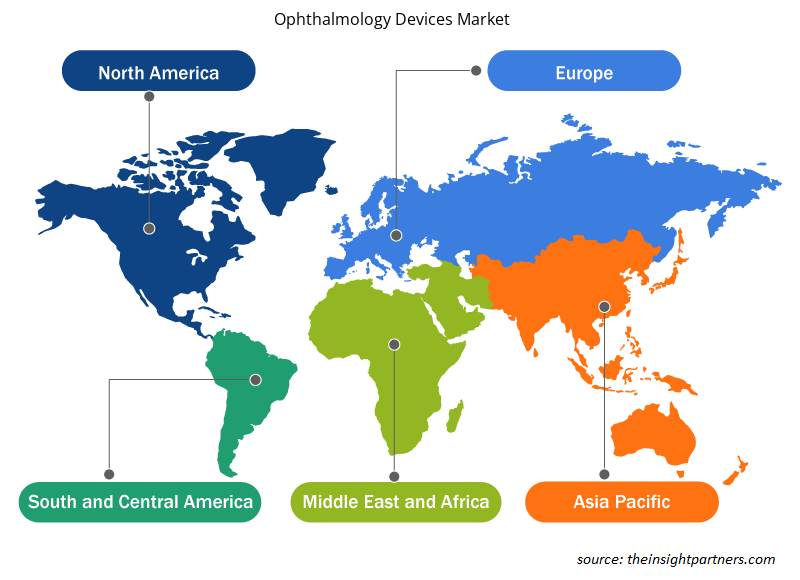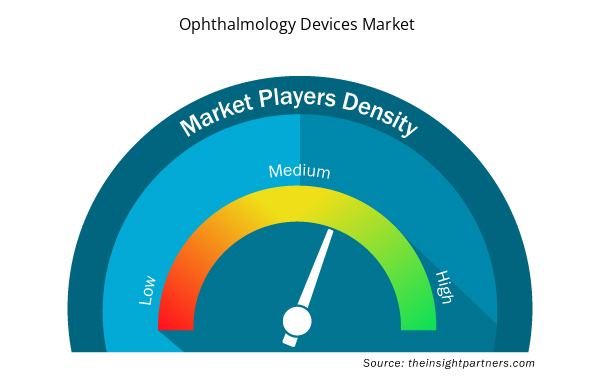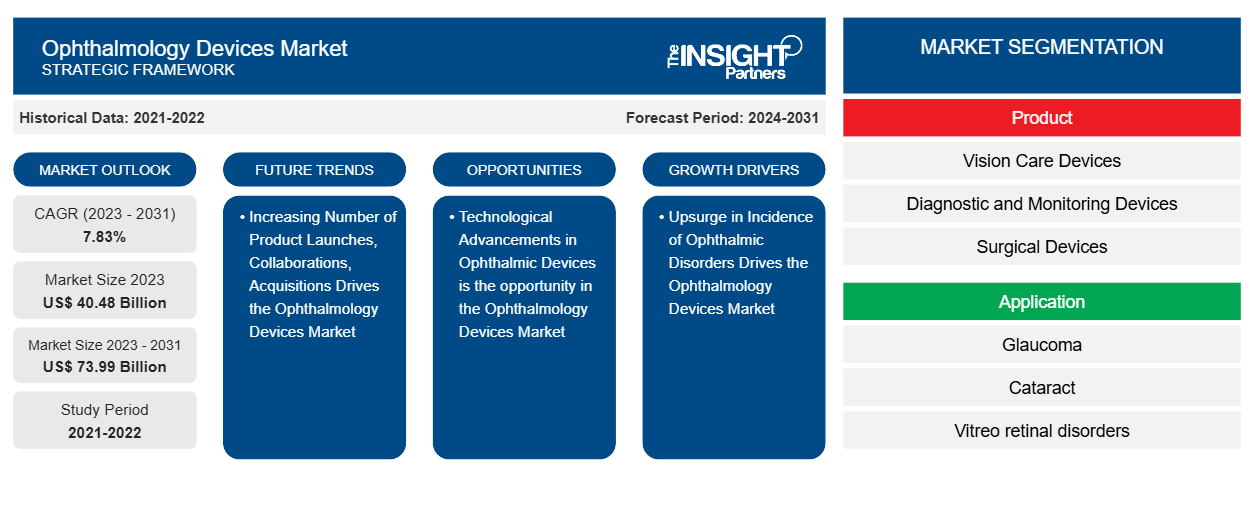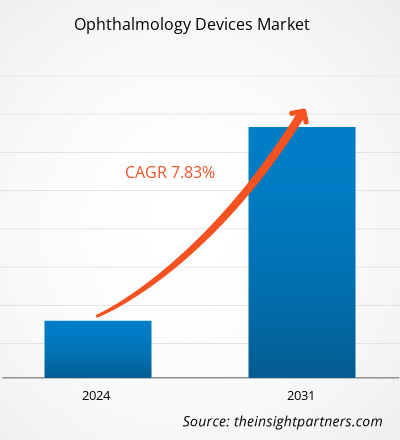Der Markt für ophthalmologische Geräte soll von 40,48 Milliarden US-Dollar im Jahr 2023 auf 73,99 Milliarden US-Dollar im Jahr 2031 anwachsen. Der Markt wird voraussichtlich zwischen 2023 und 2031 eine durchschnittliche jährliche Wachstumsrate von 7,83 % verzeichnen. Die zunehmende Verbreitung von Augenerkrankungen dürfte ein wichtiger Trend auf dem Markt für ophthalmologische Geräte bleiben.
Marktanalyse für ophthalmologische Geräte
Ophthalmologische Geräte sind für chirurgische, diagnostische und sehkorrekturbezogene Zwecke konzipiert. Diese Geräte haben im Laufe der Jahre aufgrund der hohen Inzidenz von Katarakten, Glaukomen und anderen sehbezogenen Problemen erheblich an Bedeutung gewonnen. Darüber hinaus führen Unternehmen auf dem Markt für ophthalmologische Geräte technologisch fortschrittliche Kontaktlinsen und Brillengläser ein. Die Nachfrage nach ophthalmologischen Diagnose- und Überwachungsgeräten steigt aufgrund von Fortschritten in der Medizintechnik, einer Zunahme der Prävalenz von Augenkrankheiten aufgrund veränderter Lebensstile, der zunehmenden Inzidenz chronischer Krankheiten und der wachsenden alternden Bevölkerung. Fortschrittliche Technologien wie künstliche Intelligenz (KI), Telemedizin und das Internet der Dinge (IoT) spielen bei Augenuntersuchungen eine entscheidende Rolle und steigern so die Betriebseffizienz, Genauigkeit, Kosteneffizienz und den Zugang zur ophthalmologischen Versorgung.
Marktübersicht für ophthalmologische Geräte
Technologische Innovationen waren schon immer von grundlegender Bedeutung für alle Disziplinen der Biowissenschaften, einschließlich der Augenheilkunde, da moderne Geräte der Schlüssel zu präzisen Diagnosen und verbesserten Behandlungen sind. Fortschritte bei Medikamenten, Diagnosegeräten, Lasersystemen und Operationstechniken haben eine verbesserte Diagnose von Glaukom, Katarakt und Makuladegeneration sowie trockenem Auge ermöglicht. Faktoren wie der Anstieg der Zahl von Augenerkrankungen und die zunehmende Anzahl von Produkteinführungen, Akquisitionen und Kooperationen treiben das Marktwachstum voran. Darüber hinaus stellen technologische Fortschritte bei ophthalmologischen Geräten eine Chance für den Markt dar. Die hohen Kosten für Augenoperationen sind jedoch der Hauptfaktor, der das Marktwachstum behindert.
Passen Sie diesen Bericht Ihren Anforderungen an
Sie erhalten kostenlos individuelle Anpassungen an jedem Bericht, einschließlich Teilen dieses Berichts oder einer Analyse auf Länderebene, eines Excel-Datenpakets sowie tolle Angebote und Rabatte für Start-ups und Universitäten.
- Holen Sie sich die wichtigsten Markttrends aus diesem Bericht.Dieses KOSTENLOSE Beispiel umfasst eine Datenanalyse von Markttrends bis hin zu Schätzungen und Prognosen.
Treiber und Chancen auf dem Markt für ophthalmologische Geräte
Fortschritte bei ophthalmologischen Geräten begünstigen Marktwachstum
Virtuelle Realität, 3D-Bildgebung, Big Data und künstliche Intelligenz (KI) werden in der Augenheilkunde zur Datenanalyse eingesetzt. Diese Tools haben es möglich gemacht, genaue und zuverlässige Ergebnisse zu erzielen. Tools wie KI werden beim Screening diabetischer Retinopathie, bei der Erkennung von Läsionen und bei der Überwachung des Krankheitsverlaufs (z. B. des Fortschreitens einer altersbedingten Makuladegeneration oder eines Makulaödems) eingesetzt. Diese Tools befinden sich jedoch noch in der Entwicklung, da ihre Eignung für diagnostische und prognostische Anwendungen bei Augenerkrankungen geprüft wird. Minimalinvasive Operationen wie LASIK (d. h. laserunterstützte Keratomileusis in situ), Femtosekundenlaserchirurgie , Behandlung diabetischer Retinopathie mit mehreren Wellenlängen und Ultraschall-Phakoemulsifikation werden wahrscheinlich die Nachfrage nach ophthalmologischen Geräten erhöhen und damit das allgemeine Marktwachstum vorantreiben.
Zunehmender Fokus auf Telemedizin schafft Marktchancen
Technologische Innovationen waren schon immer von grundlegender Bedeutung für alle Disziplinen der Biowissenschaften, einschließlich der Augenheilkunde, da moderne Geräte der Schlüssel zu präzisen Diagnosen und verbesserten Behandlungen sind. Fortschritte bei Medikamenten, Diagnosegeräten, Lasersystemen und Operationstechniken haben eine verbesserte Diagnose von Glaukom, Katarakt und Makuladegeneration sowie trockenem Auge ermöglicht. Virtuelle Realität, 3D-Bildgebung sowie Big Data und künstliche Intelligenz (KI) werden in der Augenheilkunde zur Datenanalyse eingesetzt. Diese Tools haben es ermöglicht, genaue und zuverlässige Ergebnisse zu erzielen. Tools wie KI werden beim Screening diabetischer Retinopathie, bei der Erkennung von Läsionen und bei der Überwachung des Verlaufs bestimmter Krankheiten wie altersbedingter Makuladegeneration oder Makulaödem eingesetzt. Diese Tools befinden sich jedoch noch in der Entwicklung, da ihre Eignung für diagnostische und prognostische Anwendungen bei Augenerkrankungen bewertet wird. Minimalinvasive Operationen wie LASIK (laserunterstützte Keratomileusis in situ), Femtosekundenlaserchirurgie, Mehrwellenlängenbehandlungen der diabetischen Retinopathie und Ultraschall-Phakoemulsifikation werden voraussichtlich die Nachfrage nach ophthalmologischen Geräten steigern und so das allgemeine Marktwachstum ankurbeln.
Marktbericht zu ophthalmologischen Geräten – Segmentierungsanalyse
Wichtige Segmente, die zur Ableitung der Marktanalyse für ophthalmologische Geräte beigetragen haben, sind Produkt, Geräte zur Sehpflege, Diagnose- und Überwachungsgeräte, chirurgische Geräte, Anwendung und Endbenutzer.
- Basierend auf dem Produkt ist der Markt für ophthalmologische Geräte in Sehhilfegeräte, chirurgische Geräte sowie Diagnose- und Überwachungsgeräte unterteilt. Das Segment der Sehhilfegeräte hatte im Jahr 2023 den größten Marktanteil.
- Basierend auf der Anwendung ist der Markt in Glaukom, Katarakt, vitreoretinale Störung, refraktäre Störung und andere unterteilt. Das Glaukomsegment hatte im Jahr 2023 einen großen Marktanteil.
- In Bezug auf den Endverbraucher ist der Markt in Krankenhäuser und Augenkliniken, akademische und Forschungslabore und andere unterteilt. Das Segment Krankenhäuser und Augenkliniken dominierte den Markt im Jahr 2023.
Marktanteilsanalyse für ophthalmologische Geräte nach Geografie
Der geografische Umfang des Marktberichts für ophthalmologische Geräte ist hauptsächlich in fünf Regionen unterteilt: Nordamerika, Asien-Pazifik, Europa, Naher Osten und Afrika sowie Süd- und Mittelamerika. Das Marktwachstum in der nordamerikanischen Region ist auf die zunehmende Verbreitung von Augenkrankheiten wie Glaukom und Katarakt sowie die Präsenz großer Hersteller in nordamerikanischen Ländern zurückzuführen.
Regionale Einblicke in den Markt für ophthalmologische Geräte
Die regionalen Trends und Faktoren, die den Markt für ophthalmologische Geräte im Prognosezeitraum beeinflussen, wurden von den Analysten von Insight Partners ausführlich erläutert. In diesem Abschnitt werden auch die Marktsegmente und die Geografie für ophthalmologische Geräte in Nordamerika, Europa, im asiatisch-pazifischen Raum, im Nahen Osten und Afrika sowie in Süd- und Mittelamerika erörtert.

- Erhalten Sie regionale Daten zum Markt für ophthalmologische Geräte
Umfang des Marktberichts zu ophthalmologischen Geräten
| Berichtsattribut | Details |
|---|---|
| Marktgröße im Jahr 2023 | 40,48 Milliarden US-Dollar |
| Marktgröße bis 2031 | 73,99 Milliarden US-Dollar |
| Globale CAGR (2023 - 2031) | 7,83 % |
| Historische Daten | 2021-2022 |
| Prognosezeitraum | 2024–2031 |
| Abgedeckte Segmente | Nach Produkt
|
| Abgedeckte Regionen und Länder | Nordamerika
|
| Marktführer und wichtige Unternehmensprofile |
|
Marktteilnehmerdichte: Der Einfluss auf die Geschäftsdynamik
Der Markt für ophthalmologische Geräte wächst rasant. Dies wird durch die steigende Nachfrage der Endnutzer aufgrund von Faktoren wie sich entwickelnden Verbraucherpräferenzen, technologischen Fortschritten und einem größeren Bewusstsein für die Vorteile des Produkts vorangetrieben. Mit der steigenden Nachfrage erweitern Unternehmen ihr Angebot, entwickeln Innovationen, um die Bedürfnisse der Verbraucher zu erfüllen, und nutzen neue Trends, was das Marktwachstum weiter ankurbelt.
Die Marktteilnehmerdichte bezieht sich auf die Verteilung von Firmen oder Unternehmen, die in einem bestimmten Markt oder einer bestimmten Branche tätig sind. Sie gibt an, wie viele Wettbewerber (Marktteilnehmer) in einem bestimmten Marktraum im Verhältnis zu seiner Größe oder seinem gesamten Marktwert präsent sind.
Die wichtigsten auf dem Markt für ophthalmologische Geräte tätigen Unternehmen sind:
- Johnson & Johnson Vision Care Inc.
- Alcon AG
- Carl Zeiss Meditec
- Bausch & Lomb Inc
- Essilor International SAS
Haftungsausschluss : Die oben aufgeführten Unternehmen sind nicht in einer bestimmten Reihenfolge aufgeführt.

- Überblick über die wichtigsten Akteure auf dem Markt für ophthalmologische Geräte
Marktnachrichten und aktuelle Entwicklungen zu ophthalmologischen Geräten
Der Markt für ophthalmologische Geräte wird durch die Erhebung qualitativer und quantitativer Daten aus Primär- und Sekundärforschung bewertet, die wichtige Unternehmensveröffentlichungen, Verbandsdaten und Datenbanken umfasst. Im Folgenden sind einige der Entwicklungen auf dem Markt für ophthalmologische Geräte aufgeführt:
- Topcon Corporation hat VISIA Imaging Srl übernommen, einen Hersteller ophthalmischer Geräte mit Sitz in einem Vorort von Florenz, Italien. Mit der Übernahme beabsichtigt Topcon, sein gut positioniertes Portfolio an Fundusbildgebungsgeräten – zu dem Funduskameras und optische Kohärenztomographie gehören – weiter zu stärken. Diese Übernahme erweitert Topcons Entwicklungs- und Produktionskapazitäten für Geräte und Software für den Vorderabschnitt. Die Übernahme soll auch seine Position als führender Hersteller ophthalmischer Diagnoseinstrumente stärken. (Quelle: Topcon, Pressemitteilung, Juli 2021)
- Iridex Corporation ist eine strategische Zusammenarbeit mit Topcon Corporation eingegangen. Iridex Corporation ist ein renommierter Anbieter innovativer ophthalmischer, laserbasierter Medizinprodukte zur Behandlung von Glaukom und Netzhauterkrankungen. Iridex hat die PASCAL-Produktlinie von Topcon übernommen und kombiniert damit seine eigene MicroPulse-Technologie mit der PASCAL-Laserplattform von Topcon. Diese Zusammenarbeit dürfte Iridex dabei helfen, seinen Marktanteil im Bereich der Laserprodukte für die Netzhautabtastung auszubauen. (Quelle: Iridex Corporation, Newsletter, März 2021)
Marktbericht zu ophthalmologischen Geräten: Umfang und Ergebnisse
Der Bericht „Marktgröße und Prognose für ophthalmologische Geräte (2021–2031)“ bietet eine detaillierte Analyse des Marktes, die die folgenden Bereiche abdeckt:
- Marktgröße und Prognose für ophthalmologische Geräte auf globaler, regionaler und Länderebene für alle wichtigen Marktsegmente, die im Rahmen des Berichts abgedeckt sind
- Markttrends für ophthalmologische Geräte sowie Marktdynamik wie Treiber, Einschränkungen und wichtige Chancen
- Detaillierte PEST/Porters Five Forces- und SWOT-Analyse
- Marktanalyse für ophthalmologische Geräte mit Blick auf wichtige Markttrends, globale und regionale Rahmenbedingungen, wichtige Akteure, Vorschriften und aktuelle Marktentwicklungen
- Branchenlandschaft und Wettbewerbsanalyse, die die Marktkonzentration, Heatmap-Analyse, prominente Akteure und aktuelle Entwicklungen auf dem Markt für ophthalmologische Geräte umfasst
- Detaillierte Firmenprofile
- Historische Analyse (2 Jahre), Basisjahr, Prognose (7 Jahre) mit CAGR
- PEST- und SWOT-Analyse
- Marktgröße Wert/Volumen – Global, Regional, Land
- Branche und Wettbewerbsumfeld
- Excel-Datensatz


- Microcatheters Market
- Aerospace Forging Market
- Medical Enzyme Technology Market
- Online Recruitment Market
- Biopharmaceutical Contract Manufacturing Market
- Artificial Intelligence in Defense Market
- Grant Management Software Market
- Ketogenic Diet Market
- Explosion-Proof Equipment Market
- Precast Concrete Market

Report Coverage
Revenue forecast, Company Analysis, Industry landscape, Growth factors, and Trends

Segment Covered
This text is related
to segments covered.

Regional Scope
North America, Europe, Asia Pacific, Middle East & Africa, South & Central America

Country Scope
This text is related
to country scope.
Häufig gestellte Fragen
Factors such as the growing prevalence of ophthalmic disorders and the rising geriatric population prone to various eye disorders. However, the high cost of ophthalmic devices and lack of awareness related to these devices in developing countries hinder the ophthalmology devices market growth. Additionally, technological advancements are anticipated to bring new ophthalmology devices market trends in the coming years.
Ophthalmology devices are medical equipment used for vision correction, eye disease diagnosis, and surgical procedures. These devices include invasive devices such as implantable devices (intraocular lenses and glaucoma stents), and noninvasive diagnostic equipment and instruments. Key factors driving the market growth include the growing prevalence of ophthalmic disorders and the rising geriatric population prone to various eye disorders. However, the high cost of ophthalmic devices and lack of awareness related to these devices in developing countries hinder the ophthalmology devices market growth. Additionally, technological advancements are anticipated to bring new ophthalmology devices market trends in the coming years.
The ophthalmology devices market majorly consists of the players, including Johnson & Johnson Vision Care Inc., Alcon AG, Carl Zeiss Meditec, Bausch & Lomb Inc, Essilor International SAS, Nidek Co Ltd, Topcon Corp, Haag-Streit AG, Ziemer Ophthalmic Systems AG, and Hoya Corp.
The ophthalmology devices market was valued at US$ 40.48 billion in 2023.
The ophthalmology devices market is expected to be valued at US$ 73.99 billion in 2031.
Based on product, the ophthalmology devices market is divided into vision care devices, surgical devices, and diagnostic and monitoring devices. The vision care devices segment held the largest market share in 2023.
Based on application, the market is segmented into glaucoma, cataract, vitreoretinal disorder, refractory disorder, and others. The glaucoma segment held a major market share in 2023.
In terms of end user, the market is segmented into hospitals and eye clinics, academic and research laboratories, and others. The hospitals and eye clinics segment dominated the market in 2023.
Trends and growth analysis reports related to Life Sciences : READ MORE..
The List of Companies - Ophthalmology Devices Market
- Johnson & Johnson Vision Care Inc.
- Alcon AG
- Carl Zeiss Meditec
- Bausch & Lomb Inc
- Essilor International SAS
- Nidek Co Ltd
- Topcon Corp
- Haag-Streit AG
- Ziemer Ophthalmic Systems AG
- Hoya Corp.
The Insight Partners performs research in 4 major stages: Data Collection & Secondary Research, Primary Research, Data Analysis and Data Triangulation & Final Review.
- Data Collection and Secondary Research:
As a market research and consulting firm operating from a decade, we have published and advised several client across the globe. First step for any study will start with an assessment of currently available data and insights from existing reports. Further, historical and current market information is collected from Investor Presentations, Annual Reports, SEC Filings, etc., and other information related to company’s performance and market positioning are gathered from Paid Databases (Factiva, Hoovers, and Reuters) and various other publications available in public domain.
Several associations trade associates, technical forums, institutes, societies and organization are accessed to gain technical as well as market related insights through their publications such as research papers, blogs and press releases related to the studies are referred to get cues about the market. Further, white papers, journals, magazines, and other news articles published in last 3 years are scrutinized and analyzed to understand the current market trends.
- Primary Research:
The primarily interview analysis comprise of data obtained from industry participants interview and answers to survey questions gathered by in-house primary team.
For primary research, interviews are conducted with industry experts/CEOs/Marketing Managers/VPs/Subject Matter Experts from both demand and supply side to get a 360-degree view of the market. The primary team conducts several interviews based on the complexity of the markets to understand the various market trends and dynamics which makes research more credible and precise.
A typical research interview fulfils the following functions:
- Provides first-hand information on the market size, market trends, growth trends, competitive landscape, and outlook
- Validates and strengthens in-house secondary research findings
- Develops the analysis team’s expertise and market understanding
Primary research involves email interactions and telephone interviews for each market, category, segment, and sub-segment across geographies. The participants who typically take part in such a process include, but are not limited to:
- Industry participants: VPs, business development managers, market intelligence managers and national sales managers
- Outside experts: Valuation experts, research analysts and key opinion leaders specializing in the electronics and semiconductor industry.
Below is the breakup of our primary respondents by company, designation, and region:

Once we receive the confirmation from primary research sources or primary respondents, we finalize the base year market estimation and forecast the data as per the macroeconomic and microeconomic factors assessed during data collection.
- Data Analysis:
Once data is validated through both secondary as well as primary respondents, we finalize the market estimations by hypothesis formulation and factor analysis at regional and country level.
- Macro-Economic Factor Analysis:
We analyse macroeconomic indicators such the gross domestic product (GDP), increase in the demand for goods and services across industries, technological advancement, regional economic growth, governmental policies, the influence of COVID-19, PEST analysis, and other aspects. This analysis aids in setting benchmarks for various nations/regions and approximating market splits. Additionally, the general trend of the aforementioned components aid in determining the market's development possibilities.
- Country Level Data:
Various factors that are especially aligned to the country are taken into account to determine the market size for a certain area and country, including the presence of vendors, such as headquarters and offices, the country's GDP, demand patterns, and industry growth. To comprehend the market dynamics for the nation, a number of growth variables, inhibitors, application areas, and current market trends are researched. The aforementioned elements aid in determining the country's overall market's growth potential.
- Company Profile:
The “Table of Contents” is formulated by listing and analyzing more than 25 - 30 companies operating in the market ecosystem across geographies. However, we profile only 10 companies as a standard practice in our syndicate reports. These 10 companies comprise leading, emerging, and regional players. Nonetheless, our analysis is not restricted to the 10 listed companies, we also analyze other companies present in the market to develop a holistic view and understand the prevailing trends. The “Company Profiles” section in the report covers key facts, business description, products & services, financial information, SWOT analysis, and key developments. The financial information presented is extracted from the annual reports and official documents of the publicly listed companies. Upon collecting the information for the sections of respective companies, we verify them via various primary sources and then compile the data in respective company profiles. The company level information helps us in deriving the base number as well as in forecasting the market size.
- Developing Base Number:
Aggregation of sales statistics (2020-2022) and macro-economic factor, and other secondary and primary research insights are utilized to arrive at base number and related market shares for 2022. The data gaps are identified in this step and relevant market data is analyzed, collected from paid primary interviews or databases. On finalizing the base year market size, forecasts are developed on the basis of macro-economic, industry and market growth factors and company level analysis.
- Data Triangulation and Final Review:
The market findings and base year market size calculations are validated from supply as well as demand side. Demand side validations are based on macro-economic factor analysis and benchmarks for respective regions and countries. In case of supply side validations, revenues of major companies are estimated (in case not available) based on industry benchmark, approximate number of employees, product portfolio, and primary interviews revenues are gathered. Further revenue from target product/service segment is assessed to avoid overshooting of market statistics. In case of heavy deviations between supply and demand side values, all thes steps are repeated to achieve synchronization.
We follow an iterative model, wherein we share our research findings with Subject Matter Experts (SME’s) and Key Opinion Leaders (KOLs) until consensus view of the market is not formulated – this model negates any drastic deviation in the opinions of experts. Only validated and universally acceptable research findings are quoted in our reports.
We have important check points that we use to validate our research findings – which we call – data triangulation, where we validate the information, we generate from secondary sources with primary interviews and then we re-validate with our internal data bases and Subject matter experts. This comprehensive model enables us to deliver high quality, reliable data in shortest possible time.


 Holen Sie sich ein kostenloses Muster für diesen Bericht
Holen Sie sich ein kostenloses Muster für diesen Bericht